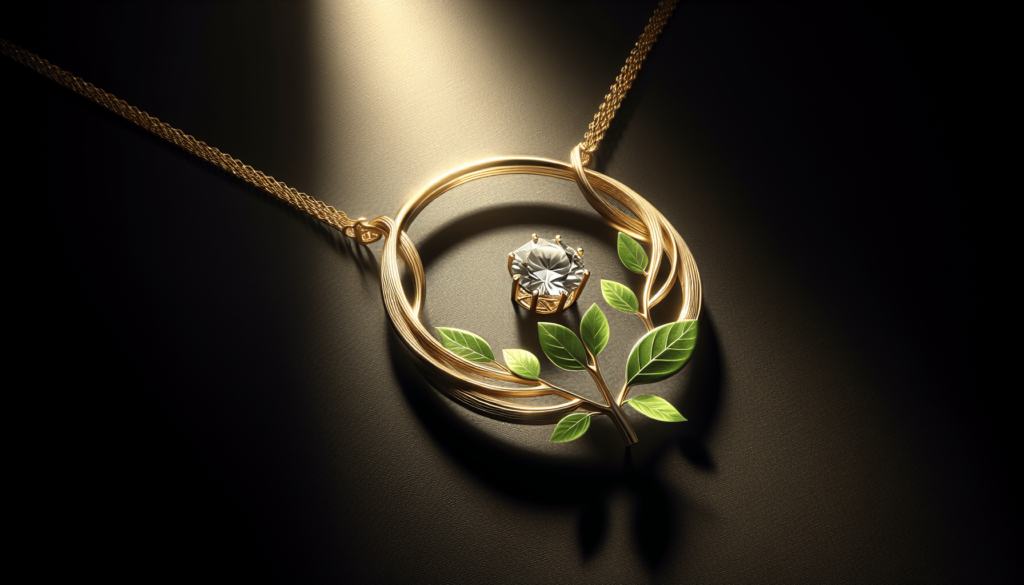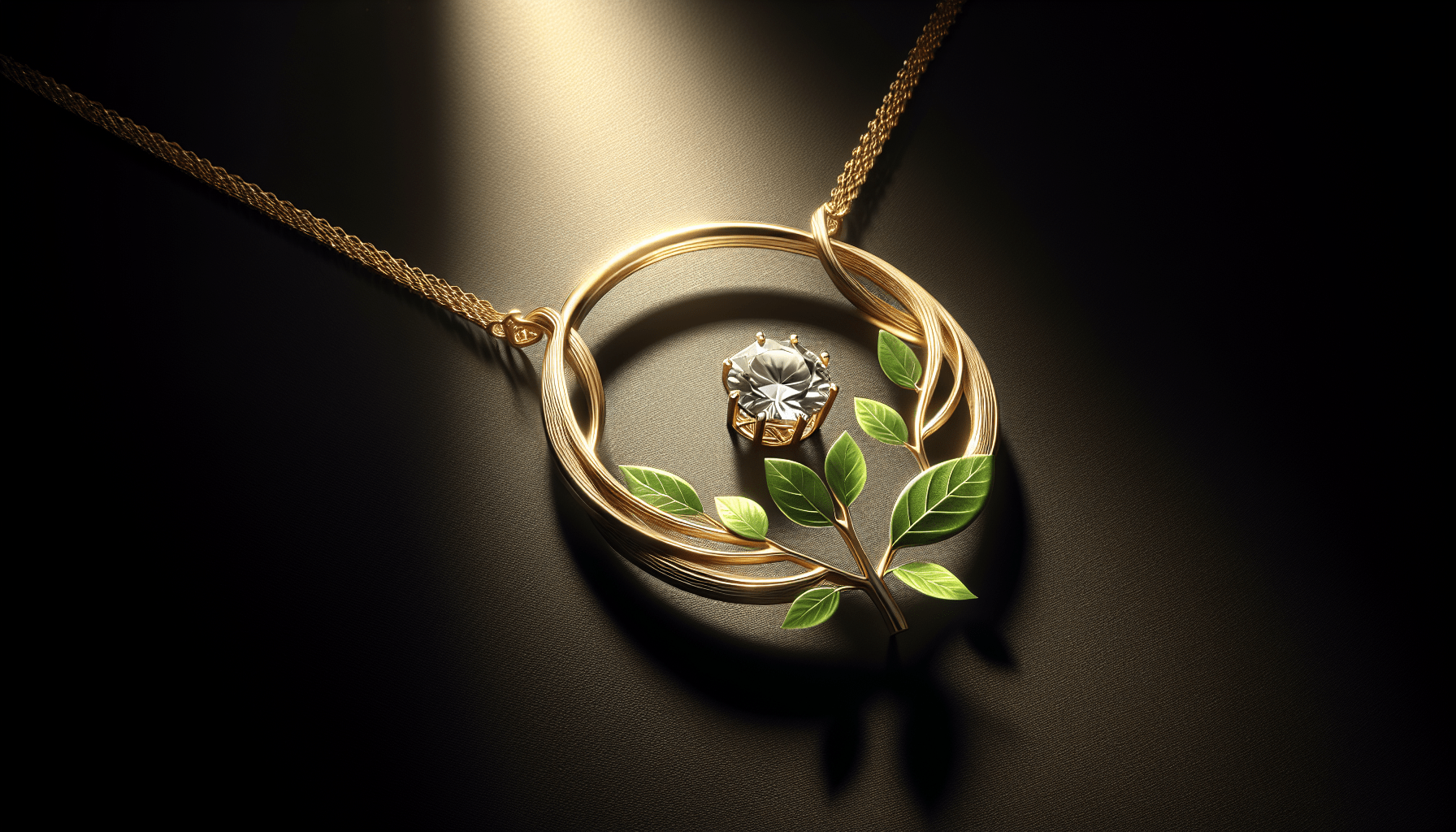Are you passionate about fashion and looking for ways to make more sustainable choices? Look no further than the Guide to Sustainable and Ethical Jewelry. This comprehensive guide will not only introduce you to the world of sustainable and ethical jewelry but also provide you with valuable insights and tips on how to make informed purchases that align with your values. From eco-friendly materials and fair trade practices to ethical sourcing and responsible manufacturing, this guide covers it all. Get ready to adorn yourself with beautiful jewelry that not only enhances your style but also makes a positive impact on the world.
Understanding Sustainable Jewelry
Definition of sustainable jewelry
Sustainable jewelry refers to jewelry that has been produced with minimal negative impact on the environment and society. These pieces are made using materials and manufacturing processes that prioritize ethical sourcing, responsible production, and social responsibility.
Importance of sustainable sourcing
Sustainable sourcing is crucial to ensure that the materials used in jewelry production are obtained in an environmentally and socially responsible manner. This includes avoiding the use of materials obtained through destructive mining methods or from conflict zones. By supporting sustainable sourcing, we can help protect ecosystems, preserve natural resources, and uphold the rights of workers.
Materials used in sustainable jewelry
In the realm of sustainable jewelry, various materials are utilized to create stunning pieces. Recycled metals, such as reclaimed gold and silver, are popular choices due to their significantly lower ecological footprint compared to freshly mined metals. Lab-grown diamonds and gemstones are also gaining popularity as ethical alternatives to mined stones, as they require no mining and have a reduced impact on the environment.
Certifications for sustainable jewelry
To ensure the authenticity of sustainable jewelry, certifications play a crucial role. Organizations such as the Responsible Jewellery Council (RJC) and the Fairtrade Foundation provide certifications that guarantee ethical sourcing, responsible production, and fair practices throughout the supply chain. By looking for these certifications, consumers can make informed choices and support brands that prioritize sustainability.
Exploring Ethical Jewelry
Definition of ethical jewelry
Ethical jewelry encompasses pieces that are produced without exploiting human rights, harming communities, or contributing to conflicts. These pieces prioritize fair labor practices, respect for cultural heritage, and the well-being of artisans involved in their creation.
Ethical issues in the jewelry industry
Unfortunately, the jewelry industry has been marred by numerous ethical issues. These include child labor, hazardous working conditions, forced labor, and the use of materials sourced from conflict zones. By understanding these issues, consumers can make conscious choices to support brands that prioritize ethical practices.
Fair trade and responsible mining
Fair trade initiatives and responsible mining practices are crucial to mitigating the negative impact of the jewelry industry. Fair trade aims to ensure that artisans receive fair wages and safe working conditions, while responsible mining focuses on minimizing environmental damage and upholding the rights of communities affected by mining activities.
Supporting artisan communities
Choosing ethical jewelry means supporting artisan communities and preserving cultural heritage. Artisans who create jewelry using traditional methods often face economic challenges, and by purchasing their products, consumers can help uplift these communities and promote sustainable development.

Choosing Sustainable Materials
Recycled metals
One of the key components of sustainable jewelry is the use of recycled metals. By utilizing reclaimed gold, silver, and other precious metals, jewelry designers reduce the demand for newly mined materials and minimize the harmful impacts of mining, such as deforestation and water pollution. Recycled metals retain their quality and beauty, making them an excellent choice for environmentally conscious consumers.
Lab-grown diamonds and gemstones
Lab-grown diamonds and gemstones offer a sustainable alternative to mined stones. These stones are created in laboratories using advanced technology that replicates the natural formation processes. They are chemically and optically identical to their mined counterparts but have a smaller carbon footprint and do not contribute to human rights abuses associated with traditional mining.
Sustainably sourced gemstones
In addition to lab-grown stones, sustainably sourced gemstones are also available in the market. These gemstones are obtained through responsible mining practices that prioritize worker safety, community welfare, and environmental protection. By opting for sustainably sourced gemstones like sapphires and rubies, consumers can enjoy beautiful jewelry while supporting responsible practices.
Alternative materials and upcycling
Sustainable jewelry designers often experiment with alternative materials and upcycling techniques to create unique pieces. They repurpose materials like wood, glass, or even recycled plastic to create stunning designs that showcase creativity and environmental consciousness. Choosing jewelry made from alternative materials or upcycled materials contributes to reducing waste and promotes sustainability.
Understanding Supply Chains
Transparency and traceability
A transparent and traceable supply chain is essential for sustainable and ethical jewelry. It allows consumers to understand the journey of their jewelry, from sourcing to production. Brands that provide information about their suppliers, materials, and manufacturing practices help customers make informed decisions and support transparency within the industry.
Conflict-free sourcing
Conflict-free sourcing refers to the practice of ensuring that the materials used in jewelry production do not originate from conflict zones. This includes diamonds and other gemstones obtained through mining activities that fund armed conflicts or human rights abuses. By supporting brands that adhere to conflict-free sourcing, we can contribute to peacebuilding efforts and protect the rights of those affected by conflicts.
Supply chain audits and certifications
To validate their commitment to sustainability and ethical practices, jewelry brands can undergo supply chain audits and obtain certifications. These audits assess the brand’s supply chain for transparency, responsible sourcing, and fair labor practices. Certifications, such as the RJC’s Chain of Custody Standard or the Fairtrade Foundation’s certification, provide assurance to consumers that the brand’s claims align with their ethical principles.
Promoting responsible labor practices
Labor practices within the jewelry industry have often been a cause for concern. Exploitative conditions, low wages, and unsafe working environments are unfortunately prevalent in some parts of the industry. However, by supporting brands that prioritize responsible labor practices, consumers can contribute to creating a fairer and more equitable industry. Brands that ensure fair wages, safe working conditions, and respect for workers’ rights contribute to a sustainable and ethical jewelry ecosystem.

Supporting Independent Designers
Benefits of supporting independent designers
Supporting independent jewelry designers not only allows consumers to discover unique and one-of-a-kind pieces but also contributes to the growth of a sustainable and ethical jewelry industry. Independent designers often prioritize environmentally friendly materials and responsible practices, giving consumers the opportunity to own jewelry that aligns with their values.
Collaborations with ethical brands
Independent designers often collaborate with ethical brands that share their values. These collaborations bring together the creative skills of the designer and the sustainable practices of the brand, resulting in stunning pieces that are made with utmost consideration for sustainability and ethics. By seeking out these collaborations, consumers can find jewelry that combines craftsmanship and conscious consumerism.
Custom and handcrafted options
One of the advantages of choosing jewelry from independent designers is the ability to have customized pieces. Independent designers often offer personalized options, allowing customers to have a say in the design and materials used. This not only ensures the uniqueness of the jewelry but also promotes waste reduction and sustainability by creating pieces that perfectly match the customer’s preferences.
Personalized and meaningful designs
Independent designers often infuse their creations with personal stories and meanings. These pieces go beyond aesthetics, as they carry stories of culture, sustainability, and individuality. By choosing personalized and meaningful designs, consumers can express their own values and support designers who prioritize sustainability and ethics.
Assessing Brand Practices
Researching brand ethics
Before purchasing jewelry, it is essential to research a brand’s ethics and values. This includes looking into their sourcing practices, labor conditions, and commitment to sustainability. Many brands openly share this information on their websites or through third-party certifications. By doing thorough research, consumers can make informed decisions and support brands that align with their own values.
Commitment to sustainability
A brand’s commitment to sustainability is a key factor in assessing its ethical practices. This includes looking at its efforts to reduce waste, lower carbon emissions, and minimize environmental impact throughout the production process. Brands that prioritize sustainable practices often demonstrate their commitment through certifications, transparent sourcing information, and initiatives focused on environmental conservation.
Corporate social responsibility initiatives
Brands that prioritize corporate social responsibility (CSR) demonstrate their commitment to making a positive impact on society. This may include initiatives such as supporting local communities, investing in education or healthcare programs, or promoting fair trade practices. By supporting brands that actively engage in CSR initiatives, consumers can contribute to the overall well-being of communities and make a difference through their jewelry purchases.
Partnerships with NGOs and nonprofits
Brands that collaborate with non-governmental organizations (NGOs) and nonprofits often demonstrate their dedication to social and environmental causes. Such partnerships can focus on various issues, including responsible sourcing, artisan empowerment, or environmental conservation. By supporting brands that actively engage in partnerships with organizations working towards positive change, consumers can amplify the impact of their jewelry choices.
Understanding Price and Value
Cost comparison of sustainable vs. conventional jewelry
When comparing the prices of sustainable and conventional jewelry, it is important to consider the long-term value and impact of the purchase. While sustainable jewelry may sometimes have a higher initial cost, it offers value in terms of supporting ethical practices, protecting the environment, and ensuring social responsibility. By considering the overall value rather than just the price tag, consumers can make choices that align with their values.
Factors influencing pricing
Several factors influence the pricing of sustainable jewelry. These include the cost of responsibly sourced materials, fair wages for artisans, and investments in sustainable production practices. Additionally, certifications and independent audits add to the overall cost of producing ethical jewelry. By understanding these factors, consumers can appreciate the value behind the price and make informed decisions.
Investing in quality and longevity
Sustainable jewelry often offers higher quality and longevity compared to mass-produced, conventional pieces. This is because sustainable jewelry is crafted with attention to detail, using materials that are built to last. Investing in quality jewelry ensures that the pieces can be enjoyed for a lifetime and passed down through generations, reducing the need for constant replacements.
Valuing craftsmanship and design
Craftsmanship and design are integral aspects of sustainable jewelry. Independent artisans and designers often pour their creativity and skill into each piece, resulting in unique and beautiful creations. By valuing craftsmanship and design, consumers can appreciate the artistry behind sustainable jewelry and support artists who prioritize quality and innovation.
Caring for Your Sustainable Jewelry
Cleaning and maintenance tips
Proper care and maintenance are essential to ensure the longevity of sustainable jewelry. Cleaning techniques may vary depending on the materials used, but generally, using mild, non-abrasive cleaners and soft brushes can help remove dirt and restore the shine of the jewelry. It is important to follow care instructions provided by the jeweler to avoid any damage or discoloration.
Proper storage and handling
To prevent damage or loss, it is important to store and handle sustainable jewelry with care. Jewelry boxes or soft pouches can protect the pieces from scratches, tangles, or exposure to air and moisture. Proper storage also reduces the risk of losing small components like earrings backs or delicate chains. Handling jewelry with clean, dry hands helps maintain its appearance and reduces the need for frequent cleaning.
Repair and refurbishment options
In case of damage or wear over time, sustainable jewelry can often be repaired or refurbished. Many jewelers offer services to fix broken chains, replace missing stones, or polish surfaces to restore the original beauty. By opting for repair and refurbishment, consumers can extend the lifespan of their jewelry and reduce the need for replacements, promoting sustainability in the long run.
Ensuring longevity and sustainability
Ensuring the longevity and sustainability of jewelry goes beyond care and maintenance. It also involves supporting brands that provide lifetime warranties or repair services, enabling consumers to keep their jewelry in good condition for years to come. Brands with a commitment to sustainability and responsible production often prioritize the durability and longevity of their products, reducing waste and environmental impact.
Sustainable Jewelry Brands to Explore
Brand 1
Brand 1 is a pioneer in sustainable jewelry, offering a wide range of designs crafted using recycled metals and ethically sourced gemstones. They are committed to transparency and have obtained certifications from industry-leading organizations. Their collection encompasses both timeless classics and modern pieces, catering to diverse styles and tastes.
Brand 2
Brand 2 is renowned for its unique designs that combine innovative materials with sustainable practices. They specialize in upcycled jewelry, transforming discarded materials into stunning pieces of wearable art. By embracing alternative materials, Brand 2 offers jewelry that is not only sustainable but also reflects the latest trends in fashion.
Brand 3
Brand 3 is dedicated to the use of lab-grown diamonds and gemstones in their jewelry. They prioritize environmental conservation and social responsibility throughout their supply chain. With a strong commitment to transparency, Brand 3 provides detailed information about the origin of their materials and their manufacturing processes, ensuring that customers can make informed choices.
Brand 4
Brand 4 is known for its collaboration with independent artisans from marginalized communities. By working directly with artisans, Brand 4 ensures fair wages and the preservation of traditional craftsmanship. Their collection showcases cultural diversity and celebrates the skills of these talented artisans, creating truly unique and ethical jewelry pieces.
Ethical Jewelry Organizations and Initiatives
Organization 1
Organization 1 is a nonprofit dedicated to promoting ethical sourcing and responsible practices within the jewelry industry. They work closely with brands to develop and implement sustainability initiatives, provide training on responsible production, and raise awareness about the importance of ethical jewelry. Their efforts contribute to transforming the industry and creating a more sustainable future.
Organization 2
Organization 2 focuses on empowering artisan communities by promoting fair trade and supporting sustainable development. They provide training and resources to artisan groups, enabling them to improve their skills, access markets, and receive fair compensation for their work. Organization 2 plays a vital role in fostering economic opportunities and preserving cultural heritage through ethical jewelry production.
Initiative 1
Initiative 1 is a collaborative effort between jewelry brands, NGOs, and government agencies to promote responsible mining practices. By conducting audits, providing training, and implementing certification programs, Initiative 1 aims to create a mining industry that respects workers’ rights, minimizes environmental impact, and contributes to the well-being of communities affected by mining activities.
Initiative 2
Initiative 2 focuses on raising awareness about the social and environmental impacts of the jewelry industry. Through educational campaigns, consumer engagement programs, and advocacy efforts, Initiative 2 encourages individuals to make conscious choices when purchasing jewelry. By promoting transparency and ethical practices, Initiative 2 strives to transform the way jewelry is produced and consumed.

